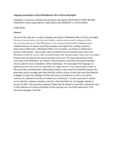Please use this identifier to cite or link to this item:
https://cris.library.msu.ac.zw//handle/11408/1699Full metadata record
| DC Field | Value | Language |
|---|---|---|
| dc.contributor.author | Rwafa, Urther | - |
| dc.date.accessioned | 2016-07-19T08:08:59Z | - |
| dc.date.available | 2016-07-19T08:08:59Z | - |
| dc.date.issued | 2012-06 | - |
| dc.identifier.uri | http://uir.unisa.ac.za/bitstream/handle/10500/9486/thesis_rwafa_u.pdf?sequence=1&isAllowed=y | - |
| dc.identifier.uri | http://hdl.handle.net/11408/1699 | - |
| dc.description | Thesis | en_US |
| dc.description.abstract | The aim of this study was to explore language censorship in Zimbabwean films in Shona and English. The study concentrated on the themes of politics, culture and economic in the genre of the documentary, feature and short film genres. It was demonstrated that the Zimbabwean laws enabled authorities to impose censorship strategies that ranged from banning, restriction, persecution of filmmakers, withdrawal of films from circulation, and threats of withdrawal of permits of film retailers. These visible, direct and banal forms of censorship have forced some filmmakers to flee the country. Most of the filmmakers who have remained in the country have been forced to deal with themes that appear harmless to the state. This state induced form of self-censorship on the filmmakers has resulted in the production of uncritical, and unreflective films whose staple diet were embedded in cultural stereotypes. The study argued that language is a signifying practice that cannot be interpreted in a single direction. Thus, despite these realities of film censorship some filmmakers deliberately encoded or used verbal and visual film language that generated surplus meanings with which the films could be re-read in ways that reveal new linguistic strategies to evade and challenge both the restrictive censorship laws as well as criticise the undemocratic political culture that has taken root in Zimbabwe. The study used eclectic theories such as Marxism, audience-reception approach, critical legal theories and language theories to analyse the films. The explanatory capacity of these theories helped to reveal the contradictory ways in which the desire to impose restrictions on film meanings was constantly undermined in the innovative language of the films. | en_US |
| dc.language.iso | en | en_US |
| dc.publisher | Unisa Publications | en_US |
| dc.subject | Zimbabwe, Film, Censorship, Language, Shona, English, Verbal, Visual, Subvert, Dominant narratives, Political film, Cultural film, Economic film, Short film genre, Documentary, Feature film | en_US |
| dc.title | Language censorship in selected Zimbabwean films in Shona and English | en_US |
| dc.type | Thesis | en_US |
| item.fulltext | With Fulltext | - |
| item.openairetype | Thesis | - |
| item.cerifentitytype | Publications | - |
| item.grantfulltext | open | - |
| item.openairecristype | http://purl.org/coar/resource_type/c_18cf | - |
| item.languageiso639-1 | en | - |
| Appears in Collections: | Theses | |
Files in This Item:
| File | Description | Size | Format | |
|---|---|---|---|---|
| Language censorship.pdf | 202.67 kB | Adobe PDF |  View/Open |
Page view(s)
130
checked on Apr 4, 2025
Download(s)
80
checked on Apr 4, 2025
Google ScholarTM
Check
Items in MSUIR are protected by copyright, with all rights reserved, unless otherwise indicated.



